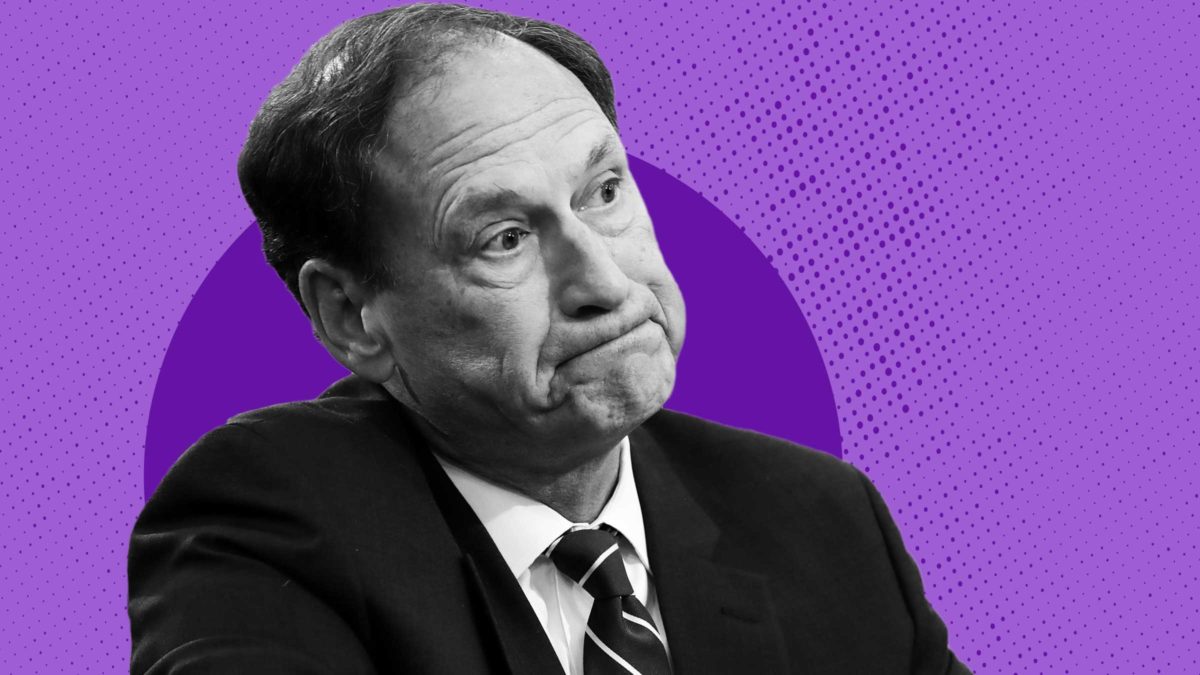For almost a decade, Justice Samuel Alito has been engaged in a relentless crusade against the labor movement, and public sector unions in particular. He has gone well beyond ruling against unions at every opportunity, however; along the way, he has essentially instructed anti-union litigants in the kinds of legal challenges they should bring and arguments they should make, and then ruled in their favor when they followed the blueprint he set out. As AFL-CIO General Counsel Craig Becker recently put it, extending the baseball metaphor so often applied to the Supreme Court, Alito is “pitching for one side.”
Alito began his side hustle assisting the anti-union movement in the 2012 case Knox v. SEIU Local 1000. Knox was about how public employees who were represented by, but not members of, a union could opt out of contributing to a particular fee assessment. None of the parties in Knox questioned the underlying rule that public employees covered by a collective bargaining agreement could be required to contribute to the costs of negotiating and administering that agreement, even if they weren’t full dues-paying union members. The Court had found such “fair-share fee” systems constitutional in a 1977 case called Abood v. Detroit Board of Education.
Although none of the parties in Knox challenged Abood, in his majority opinion, Alito broadcast his desire to overrule that 40-year-old decision. He called its rationale “an anomaly” and “a remarkable boon for unions,” and wrote that the Abood line of cases “approach, if they do not cross, the limit of what the First Amendment can tolerate.” An alarmed Justice Sotomayor waved a warning flag, writing in a concurrence that Alito’s opinion “strongly hint[ed]” that he intended to jettison Abood. Attacking a precedent the parties had not even challenged, she argued, broke the Court’s “own rules and, more importantly, disregard[ed] principles of judicial restraint.”
A network of anti-union groups enthusiastically accepted Alito’s invitation. Two years earlier, one of them had challenged a fair-share fee system for personal assistants—workers paid by the state of Illinois to provide support for disabled people in their homes. These workers had gained the right to collectively bargain in 2003, allowing them to increase their base pay from $7 to $13 per hour and launch badly-needed programs to provide health benefits and training. The challengers in that case, Harris v. Quinn, represented by the opaquely-named National Right to Work Legal Defense Foundation, had not initially challenged Abood. But after Knox, they changed their strategy in the middle of litigation, arguing that Abood should be overturned.
During oral argument, Alito went out of his way to telegraph his contempt for unions, baselessly suggesting that personal assistants had gained collective bargaining rights only because the union had made a campaign contribution to disgraced Illinois ex-governor Rod Blagojevich. And sure enough, when Harris came down in 2014, Alito wrote the majority opinion. While he did not overturn Abood, he narrowed its application by refusing to apply it to personal assistants on the grounds that they were only “partial-public employees” (a term he invented), denying the protections of Abood to workers in a vital, severely-underpaid profession. And he continued taking shots at Abood, calling its analysis “questionable on several grounds” over several pages of criticism.
Anti-union litigation groups continued their work in the years that followed. The Center for Individual Rights brought a case called Friedrichs v. California Teachers Association specifically as a vehicle to overrule Abood. Remarkably, the plaintiffs were so sure they’d win in Alito’s courtroom that they asked the lower courts to rule against them “as quickly as is practicable so that Appellants may take their claims to the Supreme Court.” This brazen litigation-by-forfeiture strategy might have worked had Justice Antonin Scalia not died before the Supreme Court could rule in Friedrichs. Meanwhile, because Senate Republicans refused to consider President Obama’s nomination of Merrick Garland to the vacant seat, the Court deadlocked 4-4.
But in 2018, after the Republican-controlled Senate confirmed Neal Gorsuch to fill that seat, Alito finally accomplished his goal in Janus v. AFSCME. Four other justices joined him in holding that a public employer violates its employees’ First Amendment rights if it requires them to pay fair-share fees.
The upshot of Janus is that public-sector unions still have a legal obligation to fairly represent every worker in a bargaining unit, but those workers can opt out of paying anything for that representation. Unions have so far managed to avoid the devastating losses in membership and resources that many feared, but anti-union groups remain hard at work to change that. Since the Janus decision, billionaire-funded anti-union groups like the Freedom Foundation have launched huge campaigns to convince public-sector union members to opt out of paying dues. At the same time, anti-union groups have brought ambitious lawsuits arguing that unions must repay the fair-share fees they collected before Janus; that public employers must stop honoring union membership cards; and even that “exclusive representation”—the basic principle that a union selected by a group of workers represents all of them—is unconstitutional. Many of these lawsuits cite Alito’s decisions in Knox, Harris, and Janus.
All federal judges are supposed to recuse themselves—to take no part in the consideration of the case—in matters in which their “impartiality might reasonably be questioned.” Despite Alito’s long history of public animosity towards unions, however, he doesn’t generally recuse himself in labor cases. This is likely because, in 1994, the Court decided that that the already-broad “impartiality” standard should be read to incorporate an “extrajudicial source doctrine.” This means that evidence that a judge is not impartial can almost never come from their judicial decisions or their statements in court—a gigantic loophole, since that is where judges do most of their public communicating. And Supreme Court justices, unlike lower court judges, have the discretion to decide for themselves whether to recuse, which makes this requirement more like a suggestion they can take or leave as they see fit.
This unchecked power to decide recusal questions helps to enable a legal system in which the justices can implement their preferred policies from the bench without facing any meaningful consequences. In areas from campaign finance to reproductive health care to COVID-19 restrictions to the right to participate in free and fair elections, this Court consistently uses its power to enact unpopular policies that Republican lawmakers have been unable to accomplish through legislation. Indeed, Alito’s war on public sector unions expanded on the high-profile efforts of former Wisconsin Governor Scott Walker and other Republican state elected officials to attack public workers’ rights to collectively bargain.
Alito’s “impartiality” in cases about unions can not only “reasonably be questioned”; it simply does not exist. There is no doubt he will rule to limit workers’ collective power at every opportunity. The only question is how quickly he’ll upend the law in order to engineer his desired result.
It is possible to imagine a legal system in which Supreme Court justices would not have the power to behave in this way. Instead, we have a Court that is both heavily invested in defending its self-conception as an impartial arbiter of the law, and powerful enough to make up its own definition of what “impartial” means. Without meaningful guardrails on cases the justices can and cannot hear, Alito remains free to bust as many unions as he likes.

